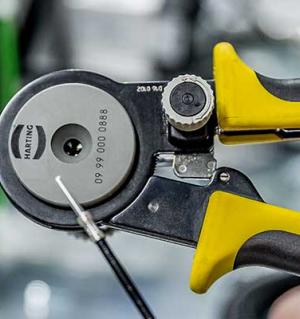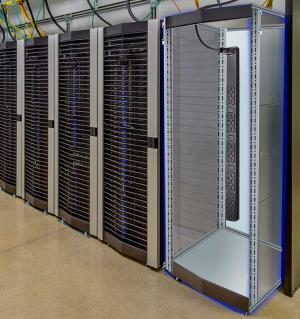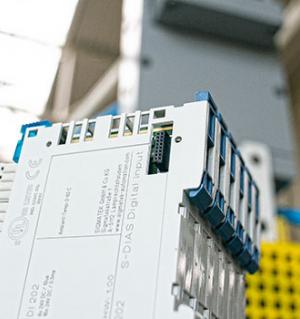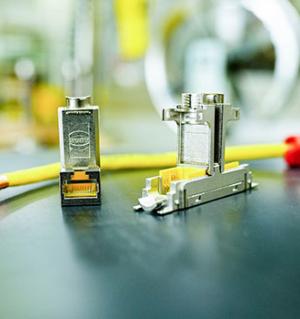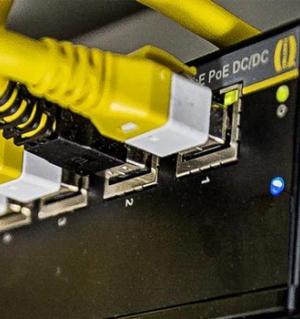Products & Solutions
Single Pair Ethernet – HARTING T1 Industrial
T1 connectivity makes Ethernet easy and affordable – and it can be used from the cloud to the smallest sensor
One pair of wires is enough – Let's Twist!
Our little giant Tw1ster brings data and power on one pair of wires to previously unattainable locations, thus challenging existing bus systems. HARTING relies on an alliance of research, industry and standardisation for single pair Ethernet. As part of this alliance, international standardisation committees have completed a multi-stage selection process in favour of the HARTING Technology Group’s SPE mating face. This also ensures planning security for the designers of new devices or sensor/actuator technology, permitting them to actively commence the implementation of SPE in the respective device technology.
Tw1ster doesn’t just feature superhero vision with its single-pair Ethernet transmission, it also has an industry standard IEC 63171-6 (formerly IEC 61076-3-125) to its name. After a multi-stage selection process, the international body of standards, the IEC, has elected the HARTING T1 Industrial as the future of single-pair Ethernet mating face for industrial applications. We congratulate our hero and will continue to work to ensure it remains the industry standard in the future.
What is Single Pair Ethernet?
SPE EBOOK AND VIDEOS
- Free eBook: Your guide for Single Pair Ethernet
- Application examples for IIoT and industry 4.0
- Spotlight on the megatrend Single Pair Ethernet
- Additional videos explaining standards & technology
The development towards ever smaller and more efficient devices in the IT world is well known. Yet, this trend is also found in other lines of business. Despite higher transmission rates and the parallel transmission of power (remote power feeding), cabling components need to be ever smaller and lighter. Based on transmission standards in accordance with IEEE 802.3, the new single-pair Ethernet technology SPE has just been integrated into new generations of automobiles and replaces CAN and other bus systems there. Controls, communication and safety functions are going to run uniformly on Ethernet in the future. This is a basic prerequisite for networked and later also autonomous driving.
SPE is now enabling the transmission of data by Ethernet using only two wires and the simultaneous power supply for terminals via PoDL – Power over Data Line. Until now, two twin wires for Fast Ethernet (100 MB) or four twin wires for Gigabit of Ethernet were necessary to achieve this. It would also be nice to use these advantages in industrial automation. SPE permits the barrier-free connection of equipment, sensors/actuator technology and much more via end-to-end IP-based communications up into the field level. By being able to integrate Ethernet interfaces onto simple sensors, cameras, reading/ID devices or similar equipment, it becomes possible to implement Integrated Industry and IIoT.
The SPE delivers a decisive advantage compared with bus systems or analogue current/voltage interfaces, as can still be found in the field level today. This makes the field level smart and simplifies the parameter setting, initialisation and programming. The set-up, operation and maintenance of equipment becomes more efficient and more cost-effective. SPE in machines, robots and in rail technology also help to save weight and space. The complete wiring is simpler and also considerably faster to install.
Consistent compatibility of devices, cables and connectors
The prerequisite for large-scale use and successful marketing of SPE technology is the consistent compatibility of devices, cables and connectors. This is ensured by the international standardisation (ISO/IEC and IEEE 802.3). At the beginning of 2018, there was a selection process held internationally by ISO/IEC for the cabling and the selection of a standardised SPE mating face, in which more than 20 international expert committees participated. Two connector faces emerged from this selection process as the preferred choice:
- For building cabling, the mating face according to IEC 63171-1: this mating face is based on the proposal of the company CommScope and is known under the synonym variant 1 (LC style) for M1I1C1E1 environments
- The mating face according to IEC 63171-6 (formerly IEC 61076-3-125) for industrial and industry-related applications: this mating face is based on HARTING's proposal, is specially designed for use in M2I2C2E2 and M3I3C3E3 environments. This SPE connector design can achieve 1 GBit/s for shorter distances and 10 MBit/sec for longer distances. It has mating faces that are plug-compatible with each other.
MICE (mechanical, ingress, climatic, electromagnetic) describes environmental conditions for installations. Thus, it provides planners and users with valuable information on the specifications of technical equipment and cabling/wiring. As part of this, the essential requirements for mechanical robustness (M), IPxx degree (I), chemical and climatic resistance (C) and electromagnetic safety (E) are described. M1I1C1E1 describes an environment that can be found in an office building and M3I3C3E3 describes a very extreme (outdoor or industrial)environment.
For HARTING, SPE is a technology topic and the starting point for many new product developments
For the user, however, SPE is not only an opportunity but also a challenge. Is this new technology just as safe as the existing solution? Can SPE also be used in process automation with line lengths of 1000 m? How much power can the end device use? When will SPE connectors and cables be available and will they be adequately standardised? HARTING takes these questions very seriously and has decided to answer them as part of a technology partnership.
The Single Pair Ethernet Industrial Partner Network, co-founded by HARTING, is an association of global technology leaders. The network has set itself the task of advancing SPE as a technology for the rapidly growing IIoT market.
The program WIPANO ("Knowledge and Technology Transfer through Patents and Standards") is an initiative of the Federal Ministry of Economic Affairs and Energy which helps to achieve this. HARTING, the University of Reutlingen and LEONI are working together in the NG200 joint project on urgent SPE issues and are simultaneously integrating their results into the international standardisation process. Recently, with the IEC 61076-6, an important step has been made towards specifying weight- and space-saving cabling for an industry-compatible single-pair mating face.
Continued work is being done in the IEC 61156-xx on the SPE cables and in the ISO/IEC JTC 1/SC 25/WG 3 and in the IEC SC 65/JWG 10 on the associated cabling standards ISO/IEC 11801 and IEC 61918 with installation guidelines and limit values for SPE. In a further step within the joint project, the issue of where the technical limits of SPE communication channels lie will be pursued. Starting in 2019, users of SPE will have access not only to products but also to valid standards and guidelines on installation and testing of components. The HARTING technology partnership support customers as they implement SPE and therefore delivers real competitive advantages. Based on this mating face, HARTING is preparing a comprehensive range of products for the industry.
Check out the technical article about the T1 Industrial® here.
Single Pair Ethernet - FAQ
What is single pair Ethernet?
Single Pair Ethernet (SPE) ensures for the first time the cost-effective use of Ethernet in every aspect of industrial automation. Single pair Ethernet uses one pair of wires to transmit data at speeds up to 1GBit/s. This makes SPE ideal for industrial applications in the age of Industry 4.0 and IIoT. This free eBook entitled Single Pair Ethernet provides detailed information on single pair Ethernet.
What are the advantages of single pair Ethernet over conventional Ethernet?
Conventional Ethernet requires two or four pairs of wires. In comparison SPE only has one pair. This helps to reduce costs and weight, and thanks to its smaller size, it enables access to new devices and to the resulting industrial field level. SPE therefore forms the basis for IIoT.
Which standards for single pair Ethernet connectors have prevailed?
In 2018 the ISO/IEC JTC 1/SC 25/WG 3 and TIA 42 committees held an international selection process to establish standardised SPE interfaces. Two mating faces emerged as the preferred choice of the over 20 committees:
- for building cabling (M1I1C1E1), the connector face according to IEC 63171-1: CommScope;
- for industrial and industry-related applications (M2I2C2E2 and M3I3C3E3), the mating face according to IEC 63171-6 (previously IEC 61076-3-125): HARTING T1 Industrial®.
As such there is significant global consensus on the SPE interfaces.
Can power also be transmitted over single pair Ethernet?
Power transmission has also been standardised for the new SPE transmission standards. PoDL Power over Data Line is the term used to describe effective power supply of up to 50W.
What data rate can be transmitted over single pair Ethernet?
The Ethernet technology based on IEEE 802.3bp 1000BASE-T1 is already available today and delivers 1 Gbit/s transmission speed over only one pair of copper wires. IEEE is currently working on a further standard for even higher data rates up to 10 Gbit/s (IEEE 802.3ch), which are required for high-resolution sensors and video transmissions. In addition, a standard for only 10Mbit/s (IEEE 802.3cg) is being developed. This standard enables transmission distances of up to 1,000 metres and can therefore replace almost all fieldbus types.
What is the origin of single pair Ethernet technology?
Development of SPE began with the BroadR-Reach Standard that was developed by the Broadcom Corporation. After the automobile industry, which needed a replacement for the CAN bus, identified this new TCP/IP-based transmission method, the IEEE 802.3 working group released the first SPE standard as standard 100BASE-T1 in IEEE 802.3bw-2015 clause 96. SPE is snow being adapted to the requirements of industry.
Does single pair Ethernet offer advantages for automation?
With universally standardised SPE infrastructure, for the first time it is feasible to use Ethernet at the field level from the cloud through to the sensor-actuator networks. This prevents disruptions in data processing and creates a unified basis for communication. It has made IIoT possible.
Which standards are there for single pair Ethernet connectors?
The following standardisation projects for SPE connectors are currently being drawn up:
- IEC 63171 – Basic standard with all the necessary specifications and test sequences (CD in preparation)
- IEC 63171-1 – SPE connectors by CommScope based on the LC interlocking for M1I1C1E1 applications (CDV available)
- IEC 63171-2 – SPE connectors by Reichle & De-Massari for M1I1C1E1 applications (CD available)
- IEC 63171-3 – SPE connectors from the company Siemon based on one pair of well-known Tera connectors for M1I1C1E1 applications (NP available)
- IEC 63171-4 – SPE connectors by BKS for M1I1C1E1 applications (NP available)
- IEC 63171-5 – SPE connectors from the company Phoenix Contact based on the IEC 63171-2 connector face for M2I2C2E2 and M3I3C3E3 applications (CD available)
- IEC 63171-6 (formerly IEC 61076-3-125) – SPE connectors from the companies HARTING and TE Connectivity for M2I2C2E2 and M3I3C3E3 applications (CDV available, FDIS in preparation and final publication 2019)
What are the advantages of single pair Ethernet in automation?
In automation, SPE enables field levels to be connected using Gbit/s Ethernet. This makes disruptions in data processing a thing of the past and with TSN every sensor has real-time capability.
What are the advantages of SPE in rail solutions?
Every 100 meters of SPE cable weighs about 1.6 kg less than standard Ethernet cable. With this weight reduction, a train operator can save about 14,000 Euro in operating costs.
Does single pair Ethernet offer advantages in robotics?
With only one pair of wires, SPE cables are much thinner making them more flexible than standard Ethernet cable. The thinner the cable, the more it is able to withstand bending and torsion cycles. The result is a longer service life and cost savings. SPE is therefore the ideal cabling for future robotic applications.
Can single pair Ethernet be transmitted over existing network cables?
This is known as cable sharing and involves the transmission of SPE over four-pair Ethernet cable. While it is theoretically possible but not practical. The transmission lengths for 1GBit SPE is currently limited to 40 meters. To ensure safe transmission, the cable would have to meet Cat. 7 standard. This is rarely the case. SPE should be seen as a practical addition to the Ethernet standard and as a replacement of fieldbusses.
What kind of applications can single pair Ethernet be used in?
Thanks to very small device sockets, SPE is the ideal technology for modern camera sensors in industrial applications. They need high data rates via a small and compact interface. Our HARTING T1 Industrial meets these requirements in accordance with IEC 63171-6.
What is the SPE Industrial Partner Network?
The SPE Industrial Partner Network is the first point of contact for users who want to set up SPE networks or devices. All member companies see Single Pair Ethernet as the basis for fast and sustainable growth of the Industrial Internet of Things (IIoT). The partner network operates its own website around Single Pair Ethernet with further information.








